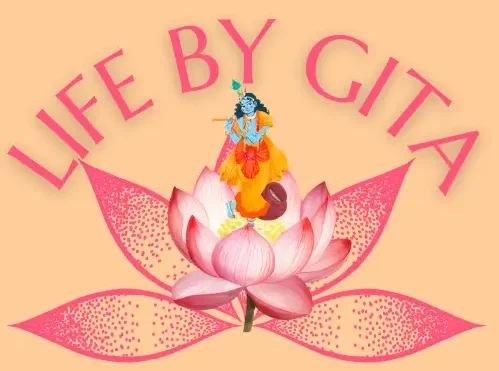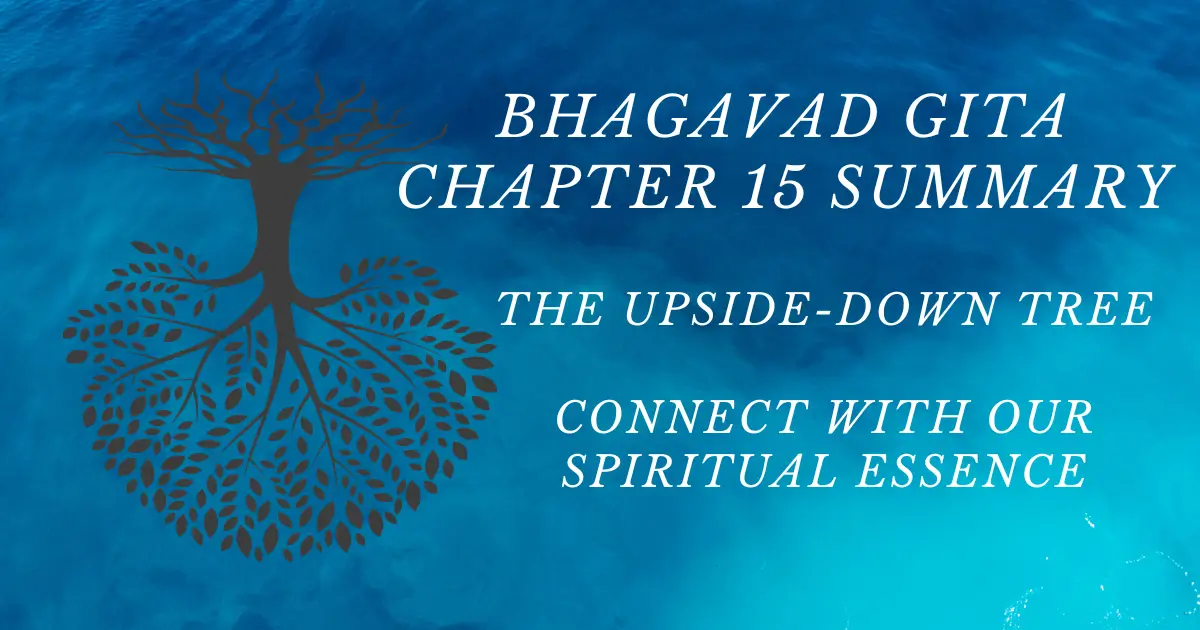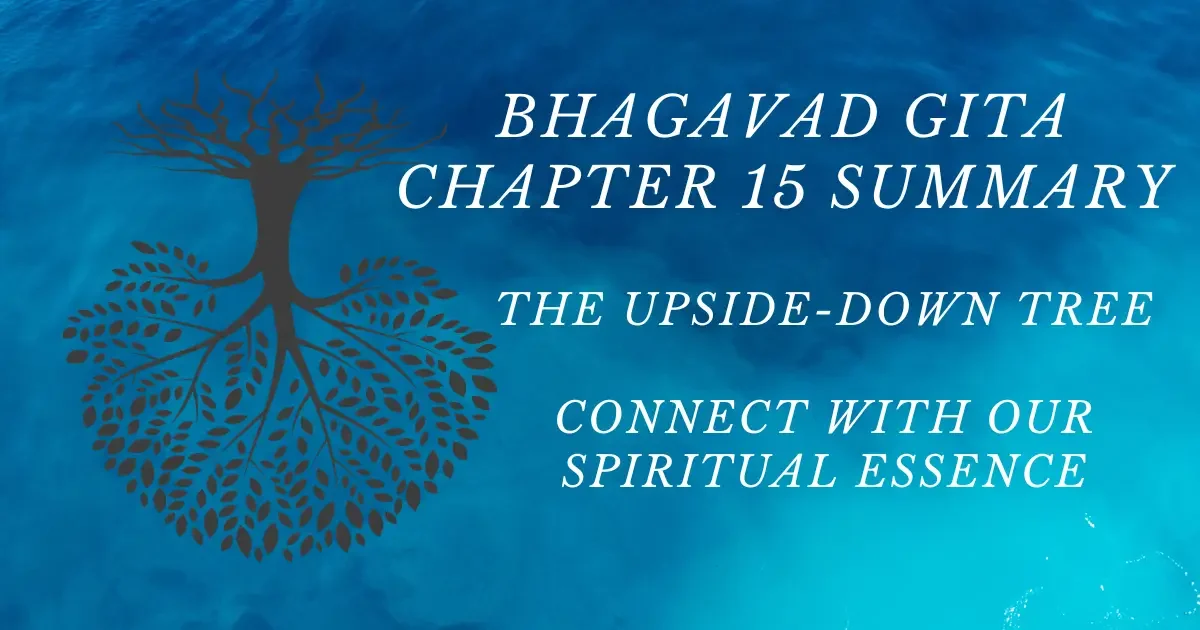
Welcome to the secrets of Bhagavad Gita! In this article, we will dive deep in the Bhagavad Gita Chapter 15 Summary which is really important to understand. Here, you will find the summary in simple language which is easy to understand and its relevance to our modern life.
1. Introduction
In the last chapter, we explored the three gunas – those fundamental qualities that influence our actions and desires. We learned how to transcend their limitations and embrace selfless action. But the journey continues! Today, we’ll crack open Bhagavad Gita Chapter 15, titled “The Yoga of the Supreme Divine Personality (Purushottam Yoga)” and delve into the profound nature of reality itself. In this chapter, Lord Krishna reveals the power of liberation from this material world. So, let’s start.
2. The Upside-Down Tree: Rooted in Illusion
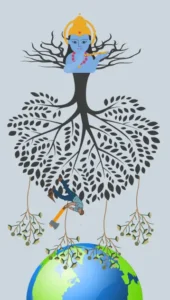
Chapter 15 opens with a powerful metaphor. Krishna describes the material world as an eternal ashwattha tree (identified with the Divine Sacred Fig tree) with its roots reaching upwards and branches sprawling down. Confused? This seemingly illogical image symbolizes our attachment to the material world. We cling to fleeting pleasures and desires, unaware of the true source of happiness that lies beyond. Here’s a famous verse that captures this essence:
“Its roots grow upward, its branches hang down; the sacred fig tree is said to be the Brahman. Its leaves are the Vedas, and the knower of the Vedas is the one who knows this.” (Chapter 15, Verse 1)
This verse might seem cryptic at first, but the meaning is profound. The Vedas, the ancient scriptures of Hinduism, represent the knowledge that can help us break free from the illusion of the material world. By understanding this, we can access the true source of happiness – the Brahman, the ultimate reality.
So, how does this connect to our modern lives? We often chase after external validation, possessions, and fleeting pleasures – the leaves of the tree. But true fulfillment comes from within, from connecting with our spiritual essence. Chapter 15 guides us towards that realization.
3. The Duality of Existence: Kshara and Akshara
The chapter goes on to explain the dual nature of reality – the Kshara (the perishable) and the Akshara (the imperishable). The Kshara represents the ever-changing world of our senses – our bodies, the environment, and even our emotions. It’s impermanent and subject to decay. Here’s a relevant verse that highlights this:
There are two kinds of beings in creation, the kshara (perishable) and the akshara (imperishable). The perishable are all beings in the material reality. The imperishable are the liberated beings. (Chapter 15, Verse 16)
This impermanence can be a source of anxiety in our modern world. We cling to things that ultimately won’t last. But the chapter offers solace by introducing the Akshara – the imperishable, unchanging reality. This represents our true Self, the soul that transcends the physical world. It is called the liberated being because when the soul recognizes the Purushottam, the Divine through Detachment and Devotion, it will then be free from the cycle of birth and death. The soul will then go to the Abode of the Divine and remain there forever.
Lord Krishna then introduces Purushottam, the Ultimate Divine Personality. This Supreme Personality is the source, sustainer, and ruler of everything in the universe. Transcending both the temporary (kshara) and the permanent (akshara), Purushottam holds a power beyond anything else. Therefore, the chapter emphasizes the importance of worshipping or acknowledging this all-encompassing force.
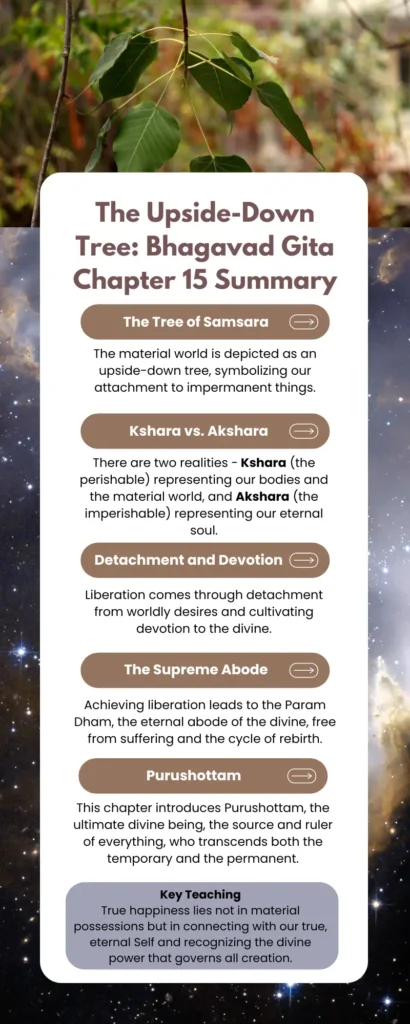
4. Conclusion: Reaching the Supreme Abode by Detachment and Devotion
So, how do we break free from the illusion of the material world and connect with the Akshara? Chapter 15 emphasizes the importance of detachment (non-attachment to worldly outcomes) and devotion (focusing our love and energy on the divine). By letting go of our desires and surrendering to a higher power, we can find true liberation.
The Bhagavad Gita Chapter 15 Summary is describing the ultimate destination – the Supreme Abode of the Divine. Those who attain this state are freed from the cycle of rebirth and experience eternal peace.
The chapter describes this process as “cutting the tree” of Samsara (the cycle of rebirth) with the sword of knowledge. Detachment acts like the sharp edge, severing our attachment to impermanent things. Devotion provides the strength and direction to swing the sword. This allows us to transcend the limitations of the material world and experience the true Self, the Akshara.
The ultimate destination for those who achieve this liberation is described as the Param Dham (the Supreme Abode). It’s not a physical location, but rather a state of pure consciousness, oneness with the divine. Imagine a place free from suffering, impermanence, and the anxieties of everyday life. This is the promise offered by Chapter 15.
Reaching this state doesn’t mean neglecting our responsibilities in the world. The Gita emphasizes performing our duties (karma) without clinging to the fruits of those actions. We can live a fulfilling life while keeping our focus on the ultimate goal of liberation.
Chapter 15 concludes with a powerful message: true liberation is not about escaping the world, but about transforming our relationship with it. By letting go of attachment and cultivating devotion, we can find inner peace and experience the divine right here, right now.
If you have any comment or feedback, feel free to leave it in the comment section at the bottom.
Must Read: Can’t Stop Scrolling? Bhagavad Gita Chapter 6 Summary Has the Answer
Want to read the Chapter 15 Summary offline? You can download its pdf version below:
Bhagavad Gita Chapter 15 Summary pdf
5. FAQs
Q1: Is Chapter 15 difficult to understand?
A: The chapter uses metaphors and symbolism, but the core message is quite profound. This summary aims to make it easier to grasp.
Q2: How can I apply the teachings of Chapter 15 to my life?
A: By practicing detachment from worldly desires and cultivating devotion to a higher power, you can find more inner peace and purpose in your daily life.
Q3: What is the significance of the upside-down tree?
A: It challenges our usual perspective and encourages us to look beyond the surface-level reality of the material world.
We hope this summary of Bhagavad Gita Chapter 15 has sparked your curiosity! Remember, the Gita is a vast ocean of wisdom, and each reading can reveal new layers of meaning. So, keep exploring, keep reflecting, and keep growing on your spiritual journey!
Further Reading
Bhakti Marga
